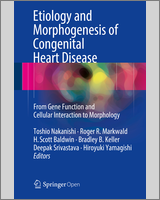Open Access This chapter is distributed under the terms of the Creative Commons Attribution-Noncommercial 2.5 License (http://creativecommons.org/licenses/by-nc/2.5/), which permits any noncommercial use, distribution, and reproduction in any medium, provided the original author(s) and source are credited. The images or other third party material in this chapter are included in the work's Creative Commons license, unless indicated otherwise in the credit line; if such material is not included in the work's Creative Commons license and the respective action is not permitted by statutory regulation, users will need to obtain permission from the license holder to duplicate, adapt or reproduce the material.
NCBI Bookshelf. A service of the National Library of Medicine, National Institutes of Health.
Nakanishi T, Markwald RR, Baldwin HS, et al., editors. Etiology and Morphogenesis of Congenital Heart Disease: From Gene Function and Cellular Interaction to Morphology [Internet]. Tokyo: Springer; 2016. doi: 10.1007/978-4-431-54628-3_50

Etiology and Morphogenesis of Congenital Heart Disease: From Gene Function and Cellular Interaction to Morphology [Internet].
Show detailsThe adult mammalian heart is incapable of regeneration after injury, as shown by the limited amount of cardiomyocyte proliferation and poor neovascularization. We recently showed that neonatal mice have a remarkable ability to regenerate damaged heart after apical resection or myocardial infarction (MI), which includes complete reconstruction of myocardial wall with vascular network [2, 3]. Although lineage tracing showed that the main source of newly formed cardiomyocyte is preexisting cardiomyocytes, it is still possible that there is a minor contribution of other types of cells to the cardiomyocyte. In addition, lineage origin of the newly formed vasculature during postnatal cardiac maturation and neonatal heart regeneration remains unclear (Fig. 50.1).
Keywords:
Heart regeneration, Cardiomyocyte proliferation, Cardiac progenitor cellsThe adult mammalian heart is incapable of regeneration after injury, as shown by the limited amount of cardiomyocyte proliferation and poor neovascularization. We recently showed that neonatal mice have a remarkable ability to regenerate damaged heart after apical resection or myocardial infarction (MI) , which includes complete reconstruction of myocardial wall with vascular network [2, 3]. Although lineage tracing showed that the main source of newly formed cardiomyocyte is preexisting cardiomyocytes, it is still possible that there is a minor contribution of other types of cells to the cardiomyocyte. In addition, lineage origin of the newly formed vasculature during postnatal cardiac maturation and neonatal heart regeneration remains unclear (Fig. 50.1).
In order to trace the lineage of non-myocyte-derived cells during neonatal heart regeneration, we utilized Rosa26-tdTomato reporter mouse line crossed with capsulin-merCremer line in which epicardial cells and interstitial fibroblasts are labeled specifically and irreversibly after induction with tamoxifen [1]. At postnatal day 0 (P0), Cre was activated by intraperitoneal injection of tamoxifen, and then MI was induced 2 days later (P2). Subsequently the hearts were harvested at 21 days after MI and tdTomato expression was examined. tdTomato+ cells were detected in the epicardium, interstitial fibroblasts, vascular endothelium, and smooth muscle in the regenerated heart. Remarkably, we could detect a very small population (1–2 cells/section) of tdTomato+ cardiomyocyte in the regenerated neonatal heart. No tdTomato+ cardiomyocyte was detected at P21 without inducing MI. These results strongly suggest that capsulin-positive cardiac progenitor cells play important roles during neonatal heart regeneration, primarily in neovasculogenesis by contributing directly to the endothelial/smooth muscle progenitor cells and to a much lesser extent rare myocytes.
References
- 1.
- Acharya A, Baek ST, Banfi S, Eskiocak B, Tallquist MD. Efficient inducible Cre-mediated recombination in Tcf21 cell lineages in the heart and kidney. Genesis. 2011;49:870–7. [PMC free article: PMC3279154] [PubMed: 21432986] [CrossRef]
- 2.
- Porrello ER, Mahmoud AI, Simpson E, Hill JA, Richardson JA, Olson EN, et al. Transient regenerative potential of the neonatal mouse heart. Science. 2011;331:1078–80. [PMC free article: PMC3099478] [PubMed: 21350179] [CrossRef]
- 3.
- Porrello ER, Mahmoud AI, Simpson E, Johnson BA, Grinsfelder D, Canseco D, et al. Regulation of neonatal and adult mammalian heart regeneration by the miR-15 family. Proc Natl Acad Sci U S A. 2013;110:187–92. [PMC free article: PMC3538265] [PubMed: 23248315] [CrossRef]
- Redox Regulation of Heart Regeneration: An Evolutionary Tradeoff.[Front Cell Dev Biol. 2016]Redox Regulation of Heart Regeneration: An Evolutionary Tradeoff.Elhelaly WM, Lam NT, Hamza M, Xia S, Sadek HA. Front Cell Dev Biol. 2016; 4:137. Epub 2016 Dec 15.
- Ezh2 is not required for cardiac regeneration in neonatal mice.[PLoS One. 2018]Ezh2 is not required for cardiac regeneration in neonatal mice.Ahmed A, Wang T, Delgado-Olguin P. PLoS One. 2018; 13(2):e0192238. Epub 2018 Feb 21.
- A p53-based genetic tracing system to follow postnatal cardiomyocyte expansion in heart regeneration.[Development. 2017]A p53-based genetic tracing system to follow postnatal cardiomyocyte expansion in heart regeneration.Xiao Q, Zhang G, Wang H, Chen L, Lu S, Pan D, Liu G, Yang Z. Development. 2017 Feb 15; 144(4):580-589. Epub 2017 Jan 13.
- Review New directions in strategies using cell therapy for heart disease.[J Mol Med (Berl). 2003]Review New directions in strategies using cell therapy for heart disease.Itescu S, Schuster MD, Kocher AA. J Mol Med (Berl). 2003 May; 81(5):288-96. Epub 2003 Apr 16.
- Review Targeting cardiomyocyte proliferation as a key approach of promoting heart repair after injury.[Mol Biomed. 2021]Review Targeting cardiomyocyte proliferation as a key approach of promoting heart repair after injury.Li S, Ma W, Cai B. Mol Biomed. 2021 Nov 5; 2(1):34. Epub 2021 Nov 5.
- Minor Contribution of Cardiac Progenitor Cells in Neonatal Heart Regeneration - ...Minor Contribution of Cardiac Progenitor Cells in Neonatal Heart Regeneration - Etiology and Morphogenesis of Congenital Heart Disease
- A History and Interaction of Outflow Progenitor Cells Implicated in “Takao Syndr...A History and Interaction of Outflow Progenitor Cells Implicated in “Takao Syndrome” - Etiology and Morphogenesis of Congenital Heart Disease
Your browsing activity is empty.
Activity recording is turned off.
See more...
 1
1 